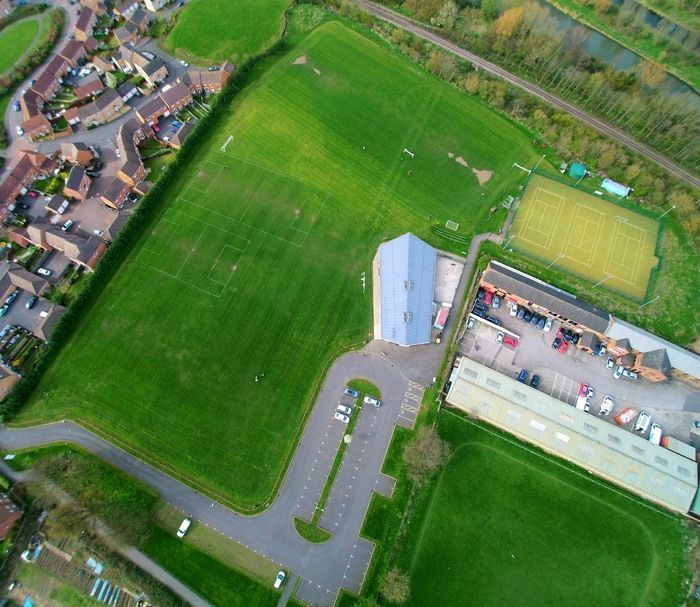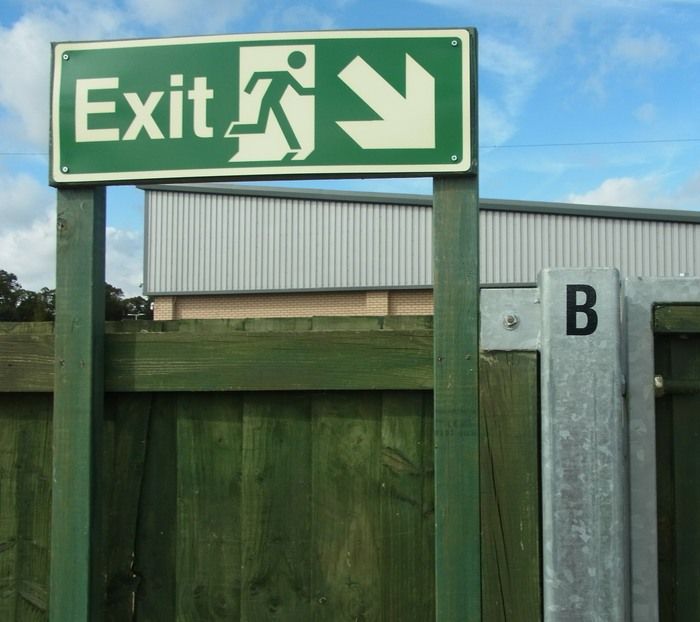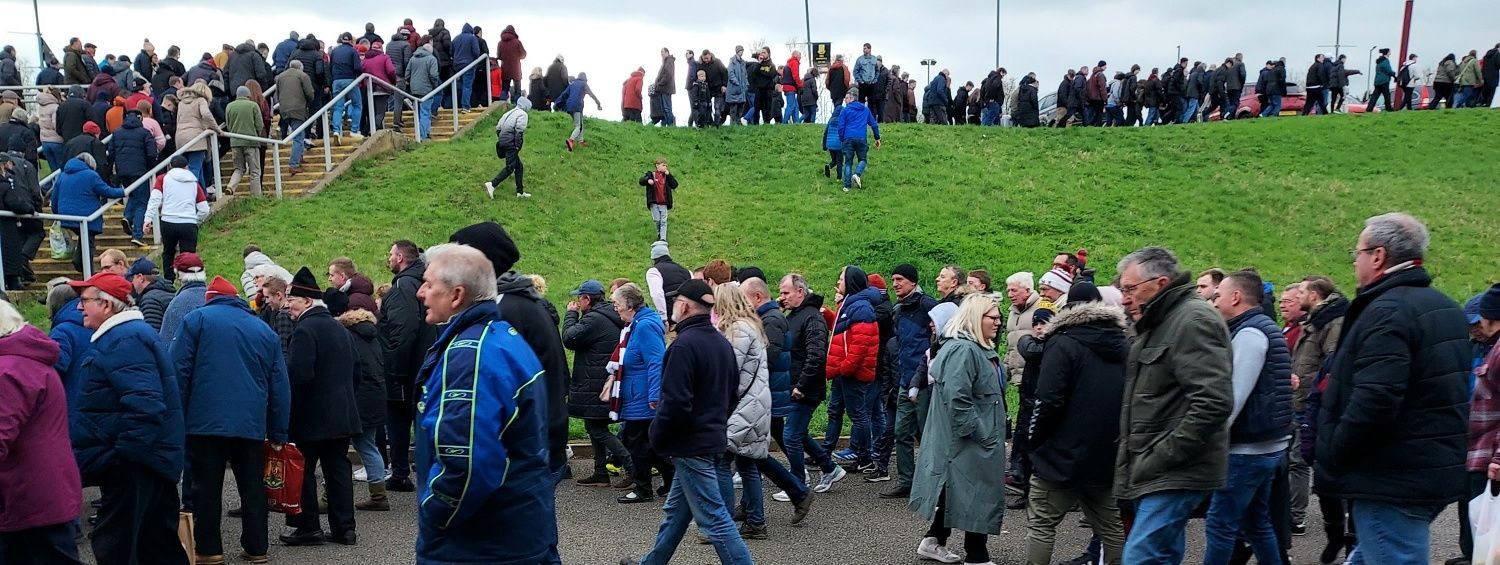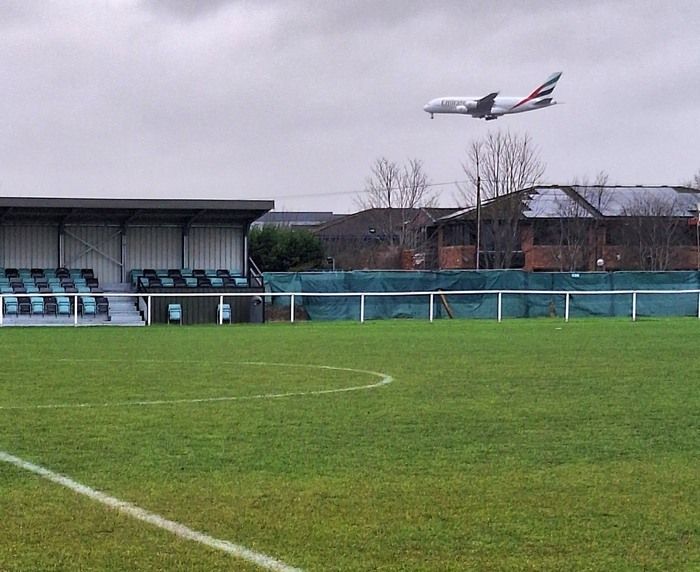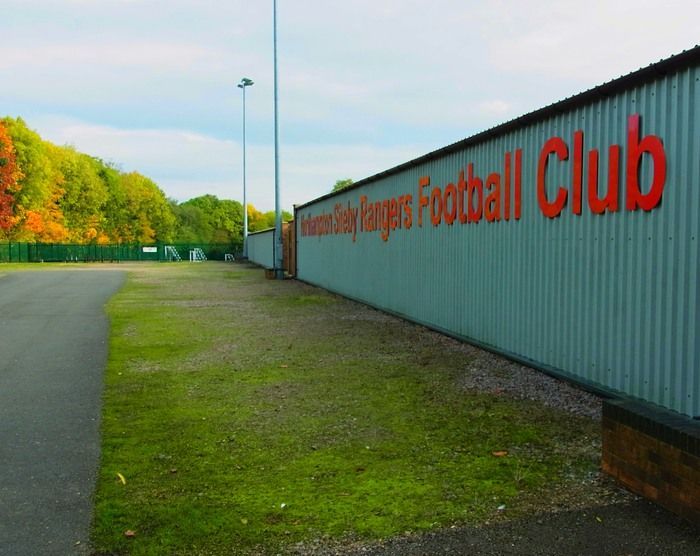groundgrading.uk
stadiumaccreditation.uk
The Terrorism (Protection of Premises) Act 2025
MARTYN'S LAW
The Terrorism (Protection of Premises) Act 2025, also known as Martyn's Law, achieved Royal assent on the 3rd April 2025. Does this affect your club? Almost certainly the answer to that will be, yes. And whilst there is a 24 month preparation period before the law is enforced, clubs need to start making preparations sooner, rather than later. Clubs should look at this as much as anything else as an opportunity to give their ground/premises a fresh point of overview and a serious health check.
In my capacity as a National League System (NLS) FA Ground Inspector, I have for many years been encouraging clubs to consider seriously their obligations to keep all of their supporters and visitors safe whilst on the premises. Physical & structural viability is crucial of course, but beyond that proper signage in a ground is incredibly important and this includes visible and effective Running Man signs. Most clubs groan when I repeatedly mention this but that is a short sighted reaction. Indeed, what I have found most surprising is that the weakest links when it comes to this are often (but not exclusively) Local Authority owned and operator run facilities and Hubs. Hopefully this Act will have the added benefit of bringing the key stakeholders for all NLS grounds to consider much more carefully all of their responsibilities.
I have also been banging the drum for invacuation policies and the use of the playing surface as a useful holding or transit area for spectators to find some safety or a route to a safe place. To this end encouraging clubs to paint their pitch entry gates Yellow and number them is another opportunity to enhance ground safety and update the Stewards Plan and/or emergency evacuation plan (EAP) with a serious and practical upgrade. With the new Act clubs will now have to look to consider invacuation as part of their plans, locking down their ground and ways to control, but also enhance spectator migration within the ground. The EPL and most EFL grounds have for many years had to consider these aspects for their events and match-day procedures. Another aspect for qualifying premises (read on) will be Zone X, which are the spaces in the immediate vicinity of the ground or, put simply the other side of your ground boundary fence.
I am old enough to recall vividly the scenes at Bradford that were televised live as the old wooden main stand burned down during a match one Saturday. That appalling tragedy surely could of been averted if the correct policies and procedures had been in place and common sense employed. I always ensure when inspecting wooden stands that the undercroft of such structures have access panels/doors so weekly inspections can be made by the club and leaf litter, rubbish and cigarette ends swept out as well as checking for structural integrity.
A Step 3 club once told me that they strictly policed a no smoking policy in their wooden stand. I suggested they open up the undercroft and look inside. It was brimming with rubbish – and cigarette ends! Lesson learned for them. I see this example and the tragedy of the Bradford fire in a similar vein (in part) to what the new Act covers, in that clubs must be considered, do proper and meaningful risk assessments in regular walks around their ground/premises with a note book and a camera and make decisions based on the reality of making improvements where needed (all emergency exits to open outward and be signed properly, as an example), keeping gangways and concourses clear of intrusion, constantly updating their Stewards plan/EAP and refreshing the training for their Stewards.
As with the above, the new Act is all about clear assessment, common sense, considered action, communication. It is nothing to be scared of and hopefully clubs will embrace the opportunities this can offer for a proper premises overview and procedures health check.
Let me explain in truncated terms what the Act will require and delve a little into the Act itself.
What exactly does the Act do?
To quote directly: 'The new Act requires certain premises and events to ensure steps have been taken to prepare for potential terrorist attacks and get ready to help keep people safe in the event of an attack. In addition, certain larger premises and events will be required to consider, and where appropriate, take steps to reduce their vulnerability to acts of terrorism'.
Under the provisions of the Act there is a tiered approach linked to different uses of premises and the number of people likely to attend at the same time. Premises that qualify for action under the Act (qualifying premises) and subject to other conditions, must have 200 or more people (including staff) attending the premises at the same time, from time to time, at least occasionally. These are referred to as standard duty premises and they fall under the provisions of the Act where the use is covered by one or more of those, as defined and football matches that involve checked or paid entry are included. This will of course, appear on the radar of every National League System club in the next 24 months. And I will go so far as to say that most NLS clubs will have qualifying premises/grounds under scope of the Act.
But, further responsibility will also affect a substantial number of clubs who will undoubtedly fall within the enhanced duty premises where 800 or more people (including staff) may reasonably be expected to attend the premises at the same time.
Open gardens, parks, recreation and sports grounds are generally outside of the provisions of the Act, but these exclusions mostly apply where they are generally open access and without a building or part thereof. Basically for NLS clubs, if measures are in place to secure or check, or charge for access, than these exclusions do not apply and the premises fall under scope of the Act. This includes members only clubs or checked entry via a non-payment ticket, pass or noted membership.
Oversight, advice and inspection? The SIA (Security Industry Authority) will provide the regulatory functions set out in the Act. This will include investigating suspected non-compliance and taking action where appropriate. Penalties and sanctions are available tools of punishment as well as restrictions on the premises/grounds of those who fail to fulfil requirements under provisions of the Act.
What Does the Act require?
'Those responsible for standard duty premises (more than 200 people) are required to have in place, so far as is reasonable and practicable, appropriate public protection procedures.' These procedures are expected to reduce the risk of physical harm to individuals if an act of terrorism takes place at the premises or in the immediate vicinity.
'Those responsible for enhanced duty premises (more than 800 people) and qualifying premises events (there are no different tiers for events) are required to have in place public protection procedures too, but they must also do more in recognition of the potentially more impactful consequence of a successful attack. They are required to have in place, so far as is reasonably practicable, appropriate public protection measures. These are measures that further the objectives of reducing the risk of physical harm to individuals, thereby providing better protection from acts of terrorism'.
How are the numbers assessed and is my club included?
Historic and current attendance data can be used to provide an assessment of expected attendees, along with any promotions being offered, local rivalries/derby matches and so forth. Advanced or capped ticket sales also provide data for a more accurate assessment of attendance (all staff/volunteers attending must be included in the figures). The Act also considers the 'immediate vicinity' to the premises/ground, but this does not mean clubs have to include the number of people using a pavement or a car park that borders the ground. However, as these areas create vulnerabilities a qualifying club, standard or enhanced premises, will need to consider these areas when ensuring appropriate procedures and measures are in place. Whatever method is used to assess the number of those attending the premises, it must be justified as a reasonable one.
It has to be stated though that generally the assessment does not concern itself with ground capacity calculations which are now required for NLS clubs at Step 4 and above. That capacity of a ground at Step 4 and above will never be below the enhanced premises threshold of 800 as the minimum capacity requirement for a Step 4 ground is 1,300. However, fire safety calculations for a building or room or clubhouse within a building are important in ascertaining the maximum number of attendees allowed at any one time for a party or function. If this is under 200 including staff, then the premises are not necessarily qualifying under the Act. If the event is ticketed or entry controlled and attendees are over 200 in number this will qualify as an event (enhanced premises). In this way clubs can understand how events at the ground are to be considered when arrangements are made. However, the premises as a whole will likely fall under scope of the Act anyway if the qualifying standard threshold (200) or enhanced threshold (800) for match attendance is breached 'occasionally' or 'from time to time'.
An assessment therefore is required of the number of individuals likely to attend all of the premises (including all staff/volunteers) and who are expected to attend at the same time. This assessment will determine whether the premises are qualifying. The wording in the Act has to be noted carefully though 'at least occasionally' and 'from time to time'. So, a Step 5 football club whose ground capacity is 660 (1 turnstile entry point), has an average attendance of 75, but plays a higher league club in a pre-season friendly with 240 in attendance, hosts a match against local rivals over the Christmas period recording a gate of 210 and hosts a League Cup Final that sells 290 tickets, most likely falls within scope of the Act, despite the clubs average attendance.
In any event clubs may not be aware at the start of the season which matches they may host that will attract a crowd of over 200 or even 800, as important cup matches may come into play as the season progresses, or the hosting of a promotion 6 pointer in April. And whilst a one-off match may not fall under scope of the Act, a series of one-off's may not be reasonable to exclude.
Preparing in advance as if the club will be qualifying and under scope of the Act, either at standard or enhanced level will therefore be best practice but more importantly ensure the club falls on the right side of the law. It is not known at the moment whether The FA's Stadium Accreditation programme will include compliance questions about how a club has assessed itself against the scope of the Act and whether that is at standard or enhanced level. But, such information would undoubtedly be valuable to the SIA in offering guidance and policing the Act. So important is this Act though, that I would be surprised if Act compliance is not included in Stadium Accreditation, in one form or another.
Current average NLS attendances for which data is available:
Step 1. 2,380. All clubs over 800 average. 0 clubs under 200 average.
Step 2. 1,170. 33 clubs over 800 average. 0 clubs under 200 average.
Step 3. 690. 21 clubs over 800 average. 3 clubs under 200 average.
Step 4. 420. 2 clubs over 800 average. 61 clubs under 200 average.
As everyone is included who is at the ground/on the premises at the same time, players, technical area occupants, match officials, committee members and staff must be added to the actual supporter attendance figure. Those figures shown above will rise by an effective amount.
Let's look at three examples:
Leamington (Step 2) average attendance to end March 2024/25 season was 637 and seems to be therefore under the enhanced premises level requirement. But, home attendances over the 800 threshold have been recorded 4 times. The ground is therefore likely to be an enhanced premises under scope of the Act.
Biggleswade Town (Step 3) average attendance to end March 2024/25 season was 164. However, attendance at home over 200 has been recorded 3 times. The ground is therefore likely to be a qualifying standard premises under the Act. The key words in the Act being 'from time to time' and 'occasionally'.
Avro (Step 4) average attendance to end of March 2024/25 season was 183. Home gate records show crowds of over 200 for 5 matches, plus an attendance of over 800 once. It could be argued that this is not an enhanced premises under the provisions of the Act because that match was a 'one off' against Bury and that club are effectively now promoted out of the division at the end of the season, but it is certainly a standard premises within scope of the Act.
None of the above take into account any pre-season friendlies or cup matches, or other events held at the ground that may have attracted paying or checked entry attendees above the thresholds. Also, clubs will have to assess all events at their ground/premises including any County or League or Schools cup finals they may be asked to host and events such as summer soccer schools they organise/host, or fetes, car boot sales and suchlike where attendance is checked or secured or charged for and is reasonably expected to attract more than 200 attendees at the same time.
What does my club need to do? Responsible Person.
Qualifying clubs, standard or enhanced will need to have a responsible person in place who will make all assessments and prepare the necessary documentation. This is the person (or Company, or Organisation) who has control of the premises in connection with their use. The responsible person will usually be the operator. Where there is more than one use the responsible person will be the relevant person in control of the premises in connection with whichever of the Schedule 1 uses is the principal use.
It is important to note that a club will not be able to delegate all responsibility to a third party that are using their ground or premises and the fine detail of that is amply covered. Maintaining control of the premises/ground, or not, are key factors in determining the responsible person/entity. This has to be looked at closely when it comes to ground sharing with co-operation and joint responsibility being key factors. Also, with one off or re-occurring events held at the ground. The host club and the ground sharing club or event management may have a responsible person each and co-production will be key. Clubs playing at a Hub or a ground owned by a Local Authority are likely to be covered by the operator being the responsible entity, but this should not be assumed. The responsible person or entity should read the Act in detail and make their assessments with assistance where necessary, from the SIA.
Responsible Person. Duties (Standard Premises).
'The responsible person must ensure that the requirements of the Act are met. They cannot delegate their legal responsibility, even if they delegate some tasks.
- Notification. The responsible person will be required to notify the SIA (Security Industry Authority) when they become responsible for the premises. They must also notify the SIA when they cease to be responsible. Regulation will set out the required timing and what information is to be provided about the person and the premises.
- Public Protection Procedures. The responsible person will be required to ensure, that so far as is reasonably practicable, appropriate public protection procedures are in place at the premises. These are procedures set out in the legislation that may be expected to reduce the risk of physical harm to individuals if an act of terrorism occurred at the premises or in the immediate vicinity of the premises. The 4 types of procedure that must be put in place if practical are: evacuation, invacuation, lockdown and communication. Anyone working at the ground will also need to have knowledge of all of the above.
Ultimately, what is appropriate, reasonable and practicable will be a consideration at each of the grounds in scope of the Act.
Responsible Person. Duties (Enhanced Premises).
'The responsible person must ensure that the requirements of the Act are met. They cannot delegate their legal responsibility, even if they delegate some tasks.
- Notification. The responsible person will be required to notify the SIA (Security Industry Authority) when they become responsible for the premises. They must also notify the SIA when they cease to be responsible. Regulation will set out the required timing and what information is to be provided about the person and the premises.
- Designate a senior individual. Where the responsible person is a company, business or other entity, they must designate a senior individual. This must be someone who has responsibility for managing the general affairs of the premises/club as a whole such as a director or partner, rather than a junior worker or club volunteer. The primary function of the senior individual is to ensure the primary person (club) complies with the legislative requirements, engaging senior management in decision-making to comply with the Act. Liability is explained within the detail.
- Public Protection Procedures. The responsible person will be required to ensure, that so far as is reasonably practicable, appropriate public protection procedures are in place at the premises. These are procedures set out in the legislation that may be expected to reduce the risk of physical harm to individuals if an act of terrorism occurred at the premises or in the immediate vicinity of the premises. The four types of procedure that must be put in place if practical are: evacuation, invacuation, lock down and communication. Anyone working at the ground will also need to have knowledge of all of the above. Mitigations must be in place to provide greater protection against acts of terrorism. Measures tailored for the specific premises/ground are required to reduce the vulnerability of the premises/ground and to reduce the risk of physical harm being being caused being caused to individuals if an act of terrorism occurred at the premises/event or nearby. Measures to put in place will vary but may be implemented through people (training), processes (bag search policy) or physical measures (CCTV as an example).
The 4 types of measures to consider are:
- Monitoring. The ground and immediate vicinity.
- Controlling movement.
- Physical safety and security.
- Security Information
Up to date documentation will play a key role for the responsible person and it must be provided in key areas of consideration. The Act covers these areas in detail.
When will Legislation come into effect?
Whilst Royal assent for the Act been passed already, there is a 24 month period of preparation before enforcement. 3rd April 2027 is the key date when all documentation and plans must be in place.
Summary.
It is likely that unless a club caps its capacity for matches and all events at their premises/ground at sub 200 or sub 800 that almost all National League System clubs will need to prepare to be qualifying standard premises or enhanced premises under scope of the Act. Capping capacity for this purpose will surely not though be an acceptable path in the eyes of the FA's Stadium Accreditation criteria or for the clubs income stream benefit! Embracing the provisions of the Act it seems will be a fact of life for club owners/directors/operators and administrators going forward.
If clubs require a general premises health & Stadium Accreditation compliance check ahead of their preparations for this Act, I can now offer a tailored inspection and report service. Email for details.
LINK The Terrorism (Protection of Premises) Act 2025
LINK The Security Industry Authority (SIA)
